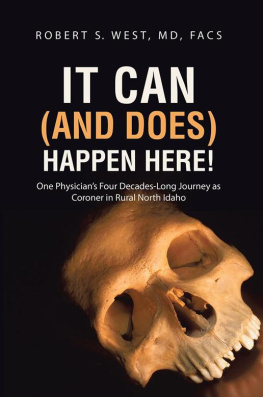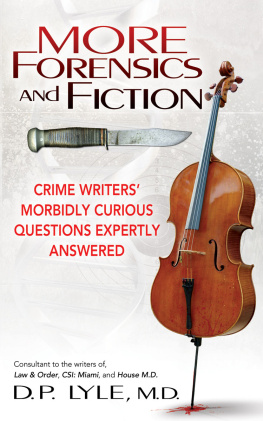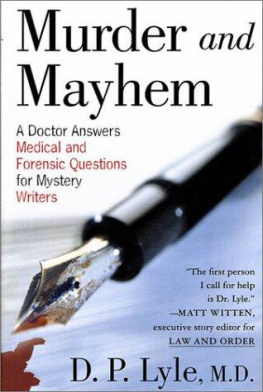IT CAN (AND DOES) HAPPEN HERE!
___________________
ONE PHYSICIANS FOUR DECADES-LONG JOURNEY AS CORONER IN RURAL NORTH IDAHO
ROBERT S. WEST, MD, FACS

Copyright 2014 Robert S. West, MD, FACS.
All rights reserved. No part of this book may be used or reproduced by any means, graphic, electronic, or mechanical, including photocopying, recording, taping or by any information storage retrieval system without the written permission of the publisher except in the case of brief quotations embodied in critical articles and reviews.
Abbott Press books may be ordered through booksellers or by contacting:
Abbott Press
1663 Liberty Drive
Bloomington, IN 47403
www.abbottpress.com
Phone: 1-866-697-5310
Because of the dynamic nature of the Internet, any web addresses or links contained in this book may have changed since publication and may no longer be valid. The views expressed in this work are solely those of the author and do not necessarily reflect the views of the publisher, and the publisher hereby disclaims any responsibility for them.
Any people depicted in stock imagery provided by Thinkstock are models, and such images are being used for illustrative purposes only.
Certain stock imagery Thinkstock.
ISBN: 978-1-4582-1544-4 (sc)
ISBN: 978-1-4582-1543-7 (hc)
ISBN: 978-1-4582-1542-0 (e)
Library of Congress Control Number: 2014906841
Abbott Press rev. date: 04/29/2014
CONTENTS
My purpose for writing this book is to trace the history and development of the Coroner/Medical Examiner system (or non-system) in the United States and, in particular, Idaho. The first Medical Examiner system was established in Boston in 1877. The appointment of Dr. Charles Norris as the New York Medical Examiner in 1890 and, later, the addition of toxicologist Alexander Gettler, PhD heralded the establishment of a true forensic examiner system which set the standard for many years.
I am not implying that the cases described represent the general run of cases, only to describe unusual incidents requiring specific knowledge, attention to detail, and which call on many resources to reach conclusions about the cause and manner of death. I found it professionally challenging and gratifying to serve the citizens of Kootenai County. I hope that the reader will find the book interesting and insightful.
A note of caution: Some descriptions and photos in this book are graphic and readers may find them disturbing. The book may not be suitable for younger readers. Parental discretion is advised. All incidents reflect my perception of events occurring during my tenure as the Kootenai County Deputy Coroner from 1970 to1984, and Coroner from 1984 until 2011. Pseudonyms have been used to protect the identities of private individuals and victims. Public officials and entities are identified by name.
It Can (And Does) Happen Here illustrates precisely why the current coroner/medical examiner system needs and deserves improvement.
Dr. West draws on four decades of death investigation in rural Kootenai County, Idaho. From routine unattended deaths to complex murders to horrific accidents, rural coroners are expected to determine the cause and manner of death with the same accuracy and precision as urban forensic facilities.
As in many jurisdictions, Idaho has minimal requisite qualifications for the coroner. This book addresses the ignorance and apathy the public has about the realities of our current system (or as he refers to it, our non system.)
He draws on a wealth of experience to focus on the pathos and sometimes puzzling aspects of the position of coroner. The occasional unexpected findings and reflection on the vagaries of the human condition are presented well.
This is an intense and absorbing read which will challenge you to become active in your community to bring about the changes he suggests.
Martha W. Hopkins
The strobe lights of multiple squad cars flashed over the neighborhood on a February night in 1986. Dr. Bob West, a general surgeon and the Kootenai County Coronerstopped at the mobile command post on Fourteenth Street in Coeur dAlene, Idaho. He contacted the Special Weapons and Tactics (SWAT) team commander to get a briefing on the incident.
We have a twenty-eight-year-old psycho holed up in this house, threatening to kill anyone who tries to enter. The windows and doors are barricaded, the phone lines have been cut, and several shots have been fired. There has been no sign of activity in the house for the past thirty minutes and the chief of police requested the coroner and paramedics to be on scene.
We do not know much else about him. The family reports a marked change in his personality over the past six months. He has become moody, withdrawn, and very paranoid and has complained of severe headaches. Kootenai County Sheriff deputies have responded to the home several times for domestic violence issues. They say he was an electrician for a local contracting firm and always been a safety-conscious worker.
SWAT team members had the house surrounded and hailed the occupant to come out. Hearing no response, they forced the lock on the front door, entered the house, and found the victim with a gunshot wound to the head. A revolver lay next to the victim with a single spent cartridge in the chamber. The paramedics on scene confirmed the death and returned to quarters. The lead detective from the sheriffs office began a systematic scene investigation, taking photos of the victim, the weapon, and the interior of the house.
After the investigators completed their initial investigation, Dr. West and the on-call funeral home personnel entered the home to remove the victim. The detective asked whether there would be an autopsy. It seemed clear the victim had committed suicide. Even though the case seemed straightforward, Dr. West explained that there would be a full autopsy, including toxicology, conducted by the Spokane County Medical Examiners (SCME) office.
Further investigation revealed that six months previously, while working as an electrician at the Coeur dAlene Resort Golf Courses signature floating fourteenth green, the victim was working in the mechanical equipment room. Mercury switches in that room operate pumps to ensure the green stays level. As the green shifts side to side, or fore and aft, the switches activate pumps, which force water into ballast tanks, keeping the greens surface level.
As the victim was working on the electrical system, one of the mercury switches exploded, vaporizing the mercury and the victim inhaled the poisonous mercuric oxide fumes. The room was subsequently ventilated. The electricians were not evaluated by physicians.
The victims toxicology from the autopsy results came back showing marked elevation of serum mercury levels. Further testing showed the effects of chronic mercury poisoning as the likely cause of deterioration in mental status of the victim.
This would explain the mad hatter syndrome symptoms in the victim. Long before Louis Carroll penned Alice in Wonderland , workers in hat factories used mercury compounds while working felt for hats. They experienced headaches, anemia, and personality changes and eventually became demented, hence, the name mad hatter.
This case was an industrial accident, not a suicide. The subsequent wrongful death lawsuit did not make the coroner any friends in the resorts management. However, it did illustrate the type of investigation necessary, even in rural Idaho.
It also demonstrates the need for coroners to make their own investigation in each case and gather the information from both the autopsy and toxicology. The elevated blood mercury levels were not expected in this case. Coroners must educate themselves of the effects of various toxins, mercury in this case, but also a variety of substances seen in other cases.
Next page











